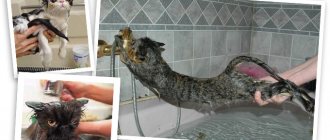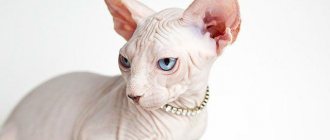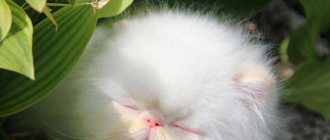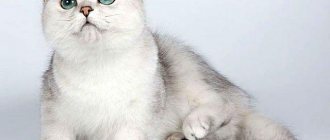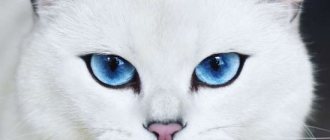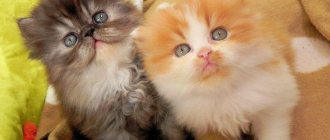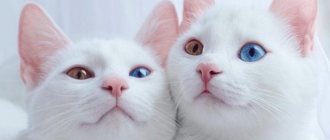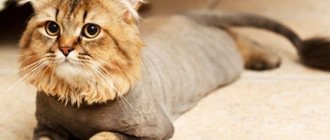One of the most popular breeds in the world is the Persian cat . Persians are loved not only for their exceptionally chic and beautifully colored fur coat, but also for their wonderful peace-loving character. Keeping such a four-legged friend in the house is true happiness for a person who loves cats. Of course, such happiness requires increased attention precisely because of its external characteristics: the structural features of the jaw and the physiology of the cat do not tolerate a careless approach to nutrition, and grooming is a serious and obligatory procedure. But this does not stop those who want to have such a fluffy and affectionate beauty in their home.
History of the origin of the Persian cat breed
global $ads_google;
//data-ad-slot=”2475549904″ $ads_google = empty($ads_google) ? false : true; ?> if ($ads_google == false) {?> $ads_google = true; ?> } ?> Traveling through the Persian province of Harassan, the Italian Pietro Della Valle returned to his homeland not alone, but with several long-haired cats at the beginning of the 16th century. Outwardly, these creatures more closely resembled an agnorka or a van, but, nevertheless, they were strikingly different from the usual feline appearance.
Today we call the breed Persian according to the first reliable mention of the country of origin of cats according to the testimony of the Dutchman Van de Werff, who studied descriptions of the life of Ancient Persia.
The further history of the Persian cat is known: the long-haired creature in the 19th century attracted the attention of German breeders who tried to breed a breed with improved coat qualities and stocky body. Then, already in the 20th century, American breeders took up the breed and “gave” the Persian his famous face with childish, naive eyes. As a result, an extreme type appeared and remained a classic one.
Popular colors
Among all cat breeds, Persians occupy 1st place in the number of colors, or points (it is close to a hundred, and breeders continue to experiment with shades).
There are cats in white, cream, black, tortoiseshell, chocolate, red and blue. The body of some animals is covered with monochromatic (solid) wool, while the fur coat of others has several different shades (2-3). The color can be simple (the color of the coat matches the color of the undercoat) or complex (the fur hairs differ in color).
The following points are the most common:
- Classic or solid. This group includes tortoiseshell cats and individuals with uniform hair color. Tortoiseshell is a combination of red and black. Only females can have it. It has been established that animals with this coat color can rarely produce offspring, so their numbers are small.
- Silver or smoky. The base of the hair is light and the end is dark.
- Tabby. The animal's fur has alternating stripes, rings and marks, often red. Such animals have yellow, less often blue eyes.
- Agouti. Each hair is colored with alternating light and dark stripes.
- Chinchilla. 87.5% of the hair length is light in tone, the tip (12.5%) is dark. Cats with this color became common at the end of the 20th century.
- Two-color, or bicolor (have 2/3 white and 1/3 chocolate, lilac, black, blue, red or cream color).
- Calico. Tricolor animals, on the coat of which areas of white color alternate with cream and blue or red and black.
There is also a color point color. The cats' bodies are light, and their muzzle, tail and paws are dark. Some scientists call such Persians Himalayan and classify them as a separate breed.
Description of Persian cats
The external characteristics of cats of the Persian breed are impressive: according to the description given in the WCF standard, you can recognize this cat, even if you have never met it in your life. The body, medium to large in size, appears stocky, short and compact. Rounded paws with tufts of hair between the toes, go well with thick and strong limbs.
The pet of this breed is famous for its strong chest, massive shoulders and generally developed muscles.
The round head is located on a short and powerful neck. Since the skull is convex, the head is proportional to the full cheeks and convex forehead; a short and wide nose with a noticeable, distinct stop looks funny on the muzzle. A feature of the appearance of cats is the location of the upper border of the nose no higher than the lower eyelid. A wide chin and a massive lower jaw look harmonious on the face.
The look of cats is interesting: it is open, questioning and very expressive.
Persians have small ears with rounded tips, which are located low and wide on the head in relation to each other.
The tail is heavily pubescent, although in itself it is short and thick, the hair on it is long.
Cats' fur is thin, silky and very thick, despite its considerable length.
Persians are not a hypoallergenic breed.
global $ads_google; //data-ad-slot=”2475549904″ $ads_google = empty($ads_google) ? false : true; ?> if ($ads_google == false) {?> $ads_google = true; ?> } ?>
The colors are numerous and are divided into several basic varieties:
- solid or solid;
- color point (without white impurities);
- ticked (tabby and agouti);
- shaded or chinchilla;
- bicolor;
- calico;
- smoky.
The color shades of the colors vary: from dark to light tones, each variety has its own criteria.
Varieties of Persian cats
Among Persian cats, there are several varieties with certain characteristics of appearance and color.
The appearance of the classic Persian is similar to an ordinary cat, since their nose is also located slightly below eye level up to 2 cm. This type is considered outdated and is characteristic of the original appearance of the animal. The muzzle is slightly flattened, a slight snub nose is noticeable. Classic Persians are bred today mainly in Europe, and are increasingly called the European type.
The extreme type has a strong snub nose and flattened muzzle. The nose of the extreme sportsman is almost at the same level with the upper eyelid. Characterized by a bulging forehead and deformed jaws. The nose is strongly “pressed” into the skull. The second name of the breed branch is American Persian.
When a Persian cat was crossed with a short-haired American cat, they got an exotic cat whose face resembled an extreme Persian, but with thick short hair.
The hybrid between extreme and classic is called the short-nosed Persian; it is an intermediate type between these varieties.
The Persians also became the founders of an interesting new breed called the Selkirk Rex.
Dimensions and weight of Persian cats
global $ads_google;
//data-ad-slot=”2475549904″ $ads_google = empty($ads_google) ? false : true; ?> if ($ads_google == false) {?> $ads_google = true; ?> } ?> The long-haired fluffies are medium to large in size by cat standards. The male's weight is always greater than the female's. A cat usually weighs between 5-7 kg, and a female cat about 3.8-5 kg. Newborn kittens with proper nutrition grow quickly, delighting owners with growth dynamics every month. Animals reach standard weight by one and a half years.
Small domestic Persian pets do not exceed 30 cm in height.
Table of weight of Persian cats by month
| Age | Female | Male |
| newborn | 95-130 gr | 110-150 gr |
| 1 month | 390-470 gr | 410-520 gr |
| 2 months | 560-910 g | 690-1100 gr |
| 3 months | 1-1.4 kg | 1.2-2 kg |
| 4 months | 1.4-2.2 kg | 1.7-2.9 kg |
| 5 months | 1.9-2.6 kg | 2.1-3.5 kg |
| 6 months | 2.2-3.3 kg | 2.6-4.3 kg |
| 8 months | 2.7-4.1 kg | 3.5-5.1 kg |
| 10 months | 3.1-4.5 kg | 4-5.8 kg |
| 1 year | 3.5-4.8 kg | 4.6-6.5 kg |
| 2 years | 3.8-5 kg | 5-7 kg |
After the cat has been bathed, you should take care of its ears, eyes, and claws.
Cat ears need to be cleaned just like human ears. Dilute a small amount of hydrogen peroxide in warm water and soak a piece of cotton wool in it. Gently wipe the inside of your cat's ear.
Cats' eyes water. You need to carefully, without putting pressure on the eye, remove the discharge with a soft cloth; If the discharge has dried, then the napkin should be soaked in warm water.
To preserve apartment renovations and furniture, cats have their claws trimmed with a special nail clipper, which can be purchased at a pet store. Having placed the cat on its back on your lap, you need to take it by the paw so as to remove each claw from its soft fingers in turn. To do this, you need to gently press on the pad of the paw and make the cat release its claws. It is necessary to trim the claw without reaching the blood vessel in the claw, which is visible visually in the light.
The litter tray should be filled with a 2.5 cm layer of filler (clay, paper or granules), which absorbs the animal’s excrement and urine well. Fillers should be changed regularly and the tray should be washed with detergents.
Kittens should not put clumping or overly scented litter in the litter tray, so as not to provoke the development of allergic sensitivity.
Habits and character of Persian cats
An obedient Persian kitten fits perfectly into a home environment, as its character makes it easy to accept the rules of behavior set by the owner of the house. Raising a baby goes smoothly; contact is quickly established between the attentive owner and the baby.
Reviews from people who keep such gorgeous cats speak about the intelligence of their pets, their restraint and affectionate nature.
Kittens are quite smart and are able to quickly learn to use a litter box, especially with the proper human approach to training the baby. A growing pet lends itself well to simple training, which brings it even closer to its owner. The difficulty may be the manifestation of disapproval on the part of the owners - the Persian cat's soul is very vulnerable.
The whole family loves to observe the habits of peaches: the cat easily gets along with other pets, does not offend poultry, and studies every nook and cranny of the home with interest. If a random mouse wanders into the house, the cat will not miss the chance to catch it - for him this is another interesting toy.
Children love to stroke such a long-haired animal, but it’s worth explaining right away that if the pet is not inclined to such caresses, it is better to leave it alone.
How to care
Caring for Persians must be thorough: they are very dependent on humans and are practically unable to take care of themselves.
Wool
The luxurious fur of the Persian cat should be combed every 2-3 days. This is done in three stages: first, superficial combing with a rare comb, then the main one with a medium comb, and finally, smoothing. At the end, you can use a spray and a special antistatic agent.
Persians need to be bathed once every 2-3 months with a specialized shampoo.
In summer, these cats are recommended to have their hair cut to avoid overheating. It is also useful during shedding, since trimming a Persian is easier than cleaning his hair every day. There are many original options for cutting Persian cats.
Eyes
Beginning owners are usually concerned with the question of why Persian cats often have watery eyes. In fact, this is due to the specific structure of the muzzle and with moderate colorless discharge is considered the norm.
Eyes should be wiped daily with a cotton pad soaked in tea, boric acid or boiled water. If the animal has light fur (for example, peach-colored), it is better not to use tea - it can color it.
If the tearing becomes particularly severe or brown discharge appears from the eyes, the animal should be taken to the veterinarian.
Ears
The auricle of these cats is very sensitive to mechanical damage, and it must be examined with extreme caution. If the ears are dirty or have excess wax, clean them with a cotton swab. If there is a dark crust in the ear, you need to show the animal to a veterinarian - most likely, treatment for parasites will be required.
Claws
There must be a scratching post in the house. In addition, the claws should be trimmed regularly: on the front paws once every 2 weeks, on the hind paws - once a month.
Feeding and caring for Persian cats
global $ads_google;
//data-ad-slot=”2475549904″ $ads_google = empty($ads_google) ? false : true; ?> if ($ads_google == false) {?> $ads_google = true; ?> } ?> The coat of the Persian breed is extremely long for cats and very thick, hence the difficulties associated with grooming. Such a fur coat requires daily attention: combing should become a habitual procedure. Otherwise, tangles will form very quickly in the tightly tangled hairs. Some breeders advise not just combing the coat, but adding a little talc to it. The cat quickly gets used to grooming, because they begin to care for the pet as soon as it gets into the house. Claws can be trimmed once every couple of weeks.
Long-haired cuties are not very happy about washing, but you still have to do it - special shampoos will help maintain the beauty of the coat and the health of the skin.
The clean peach very often licks the skin, so he must be given a special paste so that lumps of hair that get into the stomach do not harm the life of the cat.
What to feed a Persian kitten for 2 months
Keeping a Persian guest in the house dictates its own conditions: you must follow the recommended monthly feeding schedule for the kitten. An adult domestic cat is fed 2-3 times a day, with the bulk of the food being proteins: low-fat dairy products, sea fish, cheese, eggs. Peaches benefit from vegetable and grain porridges, to which you can also add pieces of cheese and fish.
More about nutrition
Nutrition is one of the most important issues in keeping a breed.
Persians should have a balanced diet:
- Half of the diet should be proteins - meat (except chicken), boiled fish, dairy products, eggs.
- A small amount of carbohydrates - porridge, bread, potatoes.
- Vitamins – olives, asparagus, boiled or raw vegetables.
- A particularly useful product is the liver - it contains substances responsible for the intensity of coat color. It also helps regulate bowel function. However, liver in excessive quantities can lead to hypervitaminosis.
It is also worth considering that you cannot mix dry food and natural food or canned food, and you cannot use dry food from different manufacturers. Each animal may have its own food preferences.
The main thing is not to feed your Persian “human” food - soups, salted or smoked fish, cutlets, etc. This food contains spices and is very harmful to cats. The appearance and health of your pet depends on proper nutrition, so this must be taken seriously.
It should also be taken into account that Persian cats are predisposed to certain diseases: kidney disease, retinal atrophy, heart disease. Taking this into account, nutritional adjustments may be necessary; a veterinarian can help the owners with this, who will tell you what food to choose and how to create a balanced diet for the pet.
Persian health
All living beings have a tendency to some kind of disease. And this wonderful breed is also susceptible to certain diseases, including polycystic kidney disease. This disease sometimes leads to kidney failure in the cat's advanced age and old age. In order not to miss the first symptoms, you need to monitor the health of your older pet and if you suspect any abnormalities, immediately contact a veterinarian. It makes sense to monitor the heart condition of your breed pet, as sometimes they develop cardiomyopathy. Since the breed is classified as large, it is prone to hip dysplasia.
Timely vaccinations will protect your dog from many health problems. Vaccination of the breed is carried out according to the schedule established by the veterinarian.
After mating, the cat becomes pregnant; the gestation period depends on the number of babies in the belly. Childbirth occurs in 63-66 days. If you do not want offspring from your pet, it needs to be castrated or sterilized at the age of 9-12 months.
Eye care for Persian cats
global $ads_google;
//data-ad-slot=”2475549904″ $ads_google = empty($ads_google) ? false : true; ?> if ($ads_google == false) {?> $ads_google = true; ?> } ?> Most often, owners are worried that the Persian cat’s eyes are watery . Due to the physiology of the structure of the muzzle in this breed, the tear streams are practically blocked, which makes the charming cat a chronic crybaby. If you eliminate this cosmetic defect every day by washing your eyes with a soft, clean cloth, this will eliminate traces of “tears” on the face and make life easier for your pet. It is impossible to treat the problem anyhow, as constant discharge will thin the hair around the eyes, and it will begin to come out.
You can alternate washing your eyes with warm water and treating the area around the eyes with a mixture of boric acid, hydrogen peroxide and starch. Sometimes, even with proper care, brown discharge flows from the cat’s eyes, or the eyes begin to fester: in these cases, do not postpone a visit to a specialist.
How long do Persian cats live?
Since the life of Persian cats takes place at home under the constant control and care of the owner, their cat’s life expectancy is on average 12-17 years
.
If you spay or neuter a cat before one year, their lifespan will increase - with good care, a pet of such a generally strong breed can live up to 20 years
. This is explained by smooth hormonal levels and human care, which also includes specialized nutrition and timely treatment of diseases.
Combing wool
Many experts believe that you need to comb your cat with a so-called slicker brush, but this is one of the most common mistakes. Slickers can be used only in exceptional cases, and it is better not to use such extreme options for grooming in household use. Caring for the hair of a Persian cat begins with the purchase of a good comb, preferably one that is made of steel and whose teeth are long, but not sharp, so as not to injure the animal.
It is better to accustom your animal to daily brushing from a very tender age. If you follow simple rules, caring for your animal will become a habit and will not cause negative emotions.
No cat will immediately sit still and wait to be brushed.
Buy a Persian kitten
The popularity of the breed provides ample opportunities for its acquisition, and non-professional people often take advantage of this. They are not responsible for the health of a small representative of such a popular breed and its physical and hereditary genetic data, so you should not choose a baby on sites that have nothing to do with professional nurseries.
global $ads_google; //data-ad-slot=”2475549904″ $ads_google = empty($ads_google) ? false : true; ?> if ($ads_google == false) {?> $ads_google = true; ?> } ?>
To avoid getting into trouble, you need to know in advance what documents should accompany the purchase of a Persian. The breeder is required to provide pedigree records, a veterinary passport indicating the vaccinations given and notes on genetic tests.
The nursery will also demonstrate the kitten’s parents; you will be able to observe all the babies in the litter and visually verify their health.
The price of kittens of this breed depends on the class to which they belong. The cost of a classic cat and an extreme cat is approximately the same. You can buy a pet-class kitten at a price from 7000
rubles, breed class from
15,000
rubles and show class from
25,000
rubles.
What to name a Persian cat
When a Persian cat appears in the house, everyone in the house wants to choose the most beautiful name for it. There is no need to rush, it is better to observe the baby and its habits; this often helps to decide on the pet’s name. Sometimes the decisive word is “said” by the color of the cat (black, blue, white, red).
For a chic fluffy girl, you should choose a gentle and regal name.
A boy with such a presentable appearance also has the right to a euphonious name. If you have difficulties with selection, you should refer to the large list of nicknames suitable for the breed, not forgetting to focus on the names in the pet’s pedigree. Names for Persian kittens
| Girl | Boy | ||
| Fairy Lulu Zara Alani Teona Comet Cinderella Vanessa Jaya Maha Lana Waxa Yuga Gerda Bessie | Ollie Joly Amber Mina Erma Fusya Annette Oda Adelia Pilka Pesya Ulla Leda Sonya Snezhka | Largo Katsap Barkhan Kumai Ferry Mefik Azar Zembi Kasper Elbar Barry Dick Maris Simba Bob | Nils Archie Moth Nemo Marcus Blair Mickey May Fluff Raf Lucky Tisha Filya Indie Ike |
Conclusions about the breed
The Persian cat is a worthy pet that will quickly become the beloved youngest child in the family. She will always be close to the owner, without imposing her attention. With the proper level of care, a cat of such a noble breed will live a long life, decorating the owner’s home with its existence. Despite the fact that his fur coat will require daily attention and care will take a lot of time, such a pet will bring a lot of joy to its owners with its affectionate character and devoted attitude towards the family.
global $ads_google; //data-ad-slot=”2475549904″ $ads_google = empty($ads_google) ? false : true; ?> if ($ads_google == false) {?> $ads_google = true; ?> } ?>

